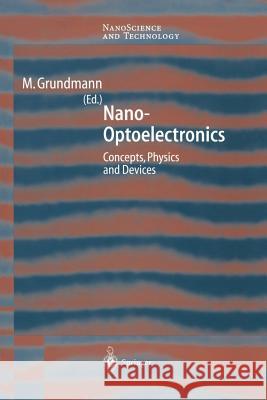Nano-Optoelectronics: Concepts, Physics and Devices » książka



Nano-Optoelectronics: Concepts, Physics and Devices
ISBN-13: 9783642628078 / Angielski / Miękka / 2012 / 442 str.
Nano-Optoelectronics: Concepts, Physics and Devices
ISBN-13: 9783642628078 / Angielski / Miękka / 2012 / 442 str.
(netto: 576,41 VAT: 5%)
Najniższa cena z 30 dni: 578,30
ok. 22 dni roboczych
Bez gwarancji dostawy przed świętami
Darmowa dostawa!
Traces the quest to use nanostructured media for novel and improved optoelectronic devices. Leading experts - among them Nobel laureate Zhores Alferov - write here about the fundamental concepts behind nano-optoelectronics, the material basis, physical phenomena, device physics and systems.
From the reviews:
"This is an excellent book covering various aspects of semiconductor quantum dots ranging from theory, growth, structural, electronic and optical properties to devices such as quantum dot lasers, photodetectors and optical amplifiers. ... will be a valuable resource for researchers and students working in the field." (Chennupati Jagadish, The Physicist, Vol. 40 (1), 2003)
I Concepts.- 1 The History of Heterostructure Lasers.- 1.1 Introduction.- 1.2 The DHS Concept and Its Application for Semiconductor Lasers.- 1.3 Quantum Dot Heterostructure Lasers.- 1.4 Future Trends.- References.- 2 Stress-Engineered Quantum Dots: Nature’s Way.- 2.1 Introduction.- 2.2 Corrugated Surface Stress and Lattice-Matched Growth: Surface Mechano-Chemistry.- 2.3 Lattice-Mismatch Stress and Growth Front Morphology Evolution.- 2.4 Island Induced Stress Evolution in Capping Layers.- 2.5 Stress-Driven Vertically Self-Organized Growth.- 2.6 Stress-Directed Spatially Selective Quantum Dot Arrays.- 2.7 Conclusion.- References.- II Physics.- 3 Characterization of Structure and Composition of Quantum Dots by Transmission Electron Microscopy.- 3.1 Introduction.- 3.2 TEM Investigations of Quantum Dots.- 3.3 Structure Investigations of Quantum Dots.- 3.4 Conclusion and Outlook.- References.- 4 Scanning Tunneling Microscopy Characterization of InAs Nanostructures Formed on GaAs(001).- 4.1 Introduction.- 4.2 Experimental Technique.- 4.3 InAs Growth on GaAs(001) by MBE.- 4.4 Post-Growth Annealing Effect on InAs Nanostructures.- 4.5 Summary.- References.- 5 Cross-sectional Scanning Tunneling Microscopy at InAs Quantum Dots.- 5.1 Introduction.- 5.2 Contrast Mechanisms in XSTM Experiments.- 5.3 Methods.- 5.4 Results.- 5.5 Discussion.- 5.6 Summary and Outlook.- References.- 6 X-ray Characterization of Group III-Nitrides (Al,In,Ga)N.- 6.1 Introduction.- 6.2 Crystal Structure and Mosaicity.- 6.3 High-Resolution X-ray Diffraction.- 6.4 Biaxial Strain-Stress Relationship.- 6.5 Experimental Results.- 6.6 Conclusions.- References.- 7 Theory of the Electronic and Optical Properties of InGaAs/GaAs Quantum Dots.- 7.1 Introduction.- 7.2 General Properties of Confined States in Quantum Dots.- 7.3 Strain in Buried Quantum Dot Structures.- 7.4 Piezoelectric Symmetry Reduction.- 7.5 Confined Single-Particle States.- 7.6 Dipole Transitions Between Zero-Dimensional States.- 7.7 Few-body Effects in the Strong Confinement Regime.- 7.8 Quantum-Confined Stark Effect.- 7.9 Shape Variation Effects.- 7.10 Reliability of State-of-the-Art Calculations.- 7.11 Conclusions.- References.- 8 Magneto-Tunneling Spectroscopy of Self-Assembled InAs Dots.- 8.1 Introduction.- 8.2 Tunneling Diodes Incorporating Self-assembled Quantum Dots.- 8.3 Magneto-tunneling Spectroscopy.- 8.4 Prospects and Conclusions.- References.- 9 Modulation Spectroscopy and Surface Photovoltage Spectroscopy of Semiconductor Quantum Wires and Quantum Dots.- 9.1 Introduction.- 9.2 Experimental Methods.- 9.3 Lineshape Considerations.- 9.4 Results and Discussion.- 9.5 Summary.- References.- 10 Optical Properties of Self-Organized Quantum Dots.- 10.1 Introduction.- 10.2 Investigated Samples.- 10.3 Excited Exciton Transitions.- 10.4 Exciton-LO-Phonon Coupling.- 10.5 Many-Particle States.- 10.6 Exciton Dynamics.- 10.7 Conclusions.- References.- 11 High Occupancy Effects and Condensation Phenomena in Semiconductor Microcavities and Bulk Semiconductors.- 11.1 Introduction.- 11.2 Experimental Techniques for Microcavity Studies.- 11.3 Non-Resonant Excitation.- 11.4 Resonant Excitation.- 11.5 Comparison of Resonant and Non-Resonant Excitation of Microcavities, Polariton Lasers and Optical Parametric Oscillators.- 11.6 Exciton Condensates and Stimulated Scattering in Direct Gap Bulk Materials and Quantum Wells.- 11.7 The Electron-Hole Liquid in Indirect Gap Semiconductors.- 11.8 Summary.- References.- III Devices.- 12 Theory of Quantum Dot Lasers.- 12.1 Introduction.- 12.2 Basic Theory of Quantum Dot Lasers.- 12.3 Carrier Distribution Function.- 12.4 Threshold Current.- 12.5 Characteristic Temperature.- 12.6 Lasing Spectra.- 12.7 High Frequency Modulation.- 12.8 Inter-Sublevel Lasers.- 12.9 Conclusion and Outlook.- References.- 13 Long-Wavelength InGaAs/GaAs Quantum Dot Lasers.- 13.1 Introduction.- 13.2 Quantum Dots.- 13.3 Growth of Long-Wavelength GaAs-Based Quantum Dots.- 13.4 Edge-Emitting Long-Wavelength Quantum Dot Lasers.- 13.5 Degradation Studies.- 13.6 Long-Wavelength Vertical-Cavity Surface-Emitting QD Lasers.- 13.7 Conclusions.- References.- 14 InP/GalnP Quantum Dot Lasers.- 14.1 Introduction.- 14.2 Single Layers.- 14.3 Stacked Layers.- 14.4 InP/InGaP Quantum Dot Lasers.- References.- 15 High Power Quantum Dot Lasers.- 15.1 High Power Laser Diodes.- 15.2 Quantum Dot Lasers.- 15.3 Characteristics of Ridge Wave-Guide Quantum Dot Lasers.- 15.4 Summary.- References.- 16 Inter-Sublevel Transitions in Quantum Dots and Device Applications.- 16.1 Introduction.- 16.2 Inter-Sublevel Absorption.- 16.3 Inter-Sublevel Emission.- 16.4 Conclusion.- References.- 17 Progress in Growth and Physics of Nitride-Based Quantum Dots.- 17.1 Introduction.- 17.2 Why QDs in GaN-Based Lasers are Important.- 17.3 Electronic States in GaN-Based QDs.- 17.4 Growth and Optical Properties of Self-Assembling InGaN QDs.- 17.5 Growth and Optical Properties of Self-Assembling GaN QDs.- 17.6 Lasing Action of InGaN QD Lasers at Room Temperature.- 17.7 Growth and Optical Properties of Selectively Grown InGaN QDs.- 17.8 Conclusion.- References.- 18 Ultrafast Optical Properties of Quantum Dot Amplifiers.- 18.1 Introduction.- 18.2 Carrier Dynamics in Semiconductor Optical Amplifiers.- 18.3 Heterodyne Pump-Probe Technique.- 18.4 Gain and Refractive Index Dynamics in In(Ga)As QD Amplifiers.- 18.5 Dephasing Time in In(Ga)As QD Amplifiers.- 18.6 Summary.- References.
Professor Dr. Marius Grundman studied physics at the Technical University of Berlin. He worked on the epitaxy and characterization of electronic and optical properties of semiconductor heterostructures and nanostructures as well as devices made from them. He has been Professor of Experimental Physics at the University of Leipzig since 2000.
This book traces the quest to use nanostructured media for novel and improved optoelectronic devices. Starting with the invention of the heterostructure laser, the progression via thin films to quasi zero-dimensional quantum dots has led to novel device concepts and tremendous improvements in device performance. Along the way sophisticated methods of material preparation and characterization have been developed. Novel physical phenomena have emerged and are now used in devices such as lasers and optical amplifiers. Leading experts - among them Nobel laureate Zhores Alferov - write here about the fundamental concepts behind nano-optoelectronics, the material basis, physical phenomena, device physics and systems.
1997-2025 DolnySlask.com Agencja Internetowa
KrainaKsiazek.PL - Księgarnia Internetowa









